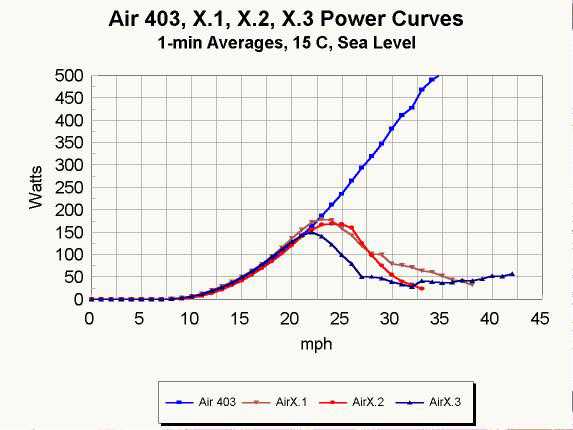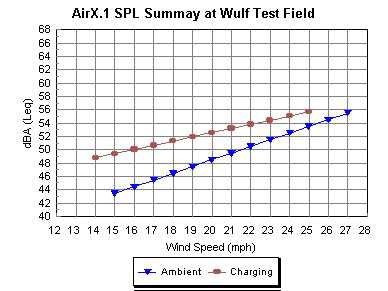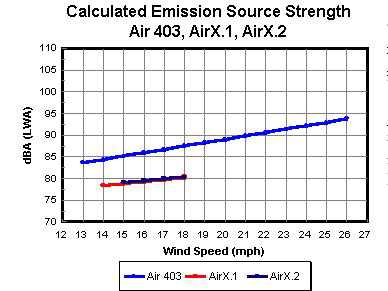

Key words: AirX, Air 403, Southwest Windpower, Small wind turbine
testing.
Beginning in early 2002 I began measuring the noise emissions from a preproduction version of the AirX at the request of Southwest Windpower. As part of these measurements I also monitored the AirX's power curve. (My report on the noise emissions from the AirX will be posted separately.)
During these tests I noted that the AirX was not meeting its power curve. Previous measurements of the Air 303h and 403 indicated that these turbines also failed to meet their advertised power curves. However, the AirX failed by a much wider margin.
In cooperation with Southwest Windpower I've tested three versions. These I call AirX.1, AirX.2, and AirX.3 respectively for lack of a better description. For the most part the difference between the versions is programming on the chip that controls the AirX's operation.
None of the AirXs tested met or even approached the power curves in Southwest Windpower's owner's manual.
Power was measured with a watt transducer and average during 1-minute periods. Wind speed was recorded on the tower with the turbine. The turbine was tested at an elevation of 4700 feet (1430 meters) in the Tehachapi Pass. Data was corrected to sea level, 15 C conditions. For more details on the test technique, altitude and temperature correction, averaging period, and possible losses in the conductors see http://www.chelseagreen.com/Wind/articles/PowerCurves.htm .
While the performance of the three versions differed, sometimes markedly, from one another, the overall performance fell far below that of the Air 403 and that of the manufacturer's proffered power curves.
Southwest Windpower clearly, and fairly state on page 28 of the AirX Owner's manual that the manufacturer's power curve represents "instantaneous wind speed". This is a significant improvement over previous power curves for the Air 303 and 403 that were not so identified. Nevertheless, purchasers will expect that the turbine produces the advertised power on a consistent basis, which it does not.
The AirX will briefly reach rated power but begin to regulate. When it does so, the average power produced is well below rated. For example, if the AirX reaches rated power and begins to regulate, the turbine may be braked for as much as half a minute. When it does so the average power is half that of rated, or 200 W. Actual performance is even less that this.
The AirX compares well with the Air 403 and meets the more conservative of the company's two power curves up to 23 mph (10 m/s).
At rated wind speed the AirX delivers only 103 W 99 W, and 51 W respectively, not the 400-525 W advertised. In the worst case, the AirX.3, the turbine only produces 10% of the advertised instantaneous power claimed. This is probably a record of some sort.
As Michael Klemen points out, this isn't the whole story. Energy production is reduced by a lower than expected power curve, but the energy generation lost is not quite so dramatic.
In a 12 mph (_5 m/s) wind regime with a Raleigh distribution, the AirX.2 and AirX.3 will generate 80% of the 388 kWh/yr produced by an Air 403. In a 14 mph (_6 m/s) wind regime with a Raleigh distribution the AirX.2 and AirX.3 will generate 65% of the 612 kWh/yr produced by an Air 403.
The AirX is both subjectively and quantitatively quieter than the Air 303 and Air 403. However, this is accomplished at a significant sacrifice of performance.


Background
Southwest Windpower's Air 403 was notoriously noisy. While not the noisiest wind turbine ever made, its widespread distribution caused an unusual number of noise complaints.
In late 2001 Southwest Windpower asked me to measure the noise from a preproduction version of the AirX. Beginning in 2002 and through the first half of 2002, I conducted a series of noise measurements on two versions of the AirX. For lack of a better descriptor I called them AirX.1 and AirX.2. I also measured the power curve on a third version, the AirX.3 but I have not made any noise measurements on this unit.
I've withheld publishing the data collected until now for several reasons. First, I had other obligations. Second, I considered the versions I tested defective products and returned them to the manufacture for correction. They were defective because they failed to meet the manufacturer's power curve. While the noise measurements on these units were complete, the fact that the product would likely be modified by the manufacturer to correct the power curve defect suggested that the final production version would not be represented by my tests.
The final version I received, the AirX.3, operated similarly to the AirX.2 and the noise emissions are likely comparable. Further, Southwest Windpower has been shipping various versions of the AirX for more than one year. I have no idea how my versions compare with current production.
For a complete description of the rationale for testing, the methods employed, the terminology used, and my test equipment, see http://www.chelseagreen.com/Wind/articles/noiseswt.htm .
Critical to understanding the following data is the difference between sound pressure levels of ambient noise, and noise with the turbine operating. It is the difference between ambient and the turbine noise plus ambient that determines the noisiness of the wind turbine. The difference determines the noise from the turbine at a specified distance from the turbine. This calculation in sound pressure level is then used to arrive at the source emission strength in sound power level (LWA). The latter is the noise at the source, the wind turbine. This value can be used to project noise at varying distances from the turbine and can be used to compare one wind turbine with another.
Air 403
To recapitulate earlier results on the Air 403, in winds from 8-10 m/s (18-22 mph), the Air 403 would emit an annoying "buzz" most of the time. The Air 403 sound power level or emission source strength (LWA) was 88 dBA at 8 m/s and 91 dBA at 10 m/s.
AirX
The AirX is so significantly quieter than the Air 403 that it was difficult to measure a sufficient difference between ambient and turbine plus ambient in wind speeds greater than 18 mph (8 m/s) to calculate valid values for sound power levels above this speed. In the accompanying chart for the SPL Summary for the AirX.1, the ambient noise can be seen rising steeply with increasing wind speed (wind noise in nearby willows) while the noise from the AirX rises less rapidly.
As seen in the second chart, Calculated Emission Source Strength, both the AirX.1 and the AirX.2 emitted about the same amount of noise. The sound power level for the AirX.1 and AirX.2 at 8 m/s (18 mph) is 80 dBA or 8 dBA quieter than the Air 403.
The AirX accomplishes this by stalling the rotor or turning the turbine off so the blades don't begin to flutter. This is a very effective method for reducing the noise emitted by the AirX, but it does so at a cost. The AirX fails to meet its power curve by a wide margin.

